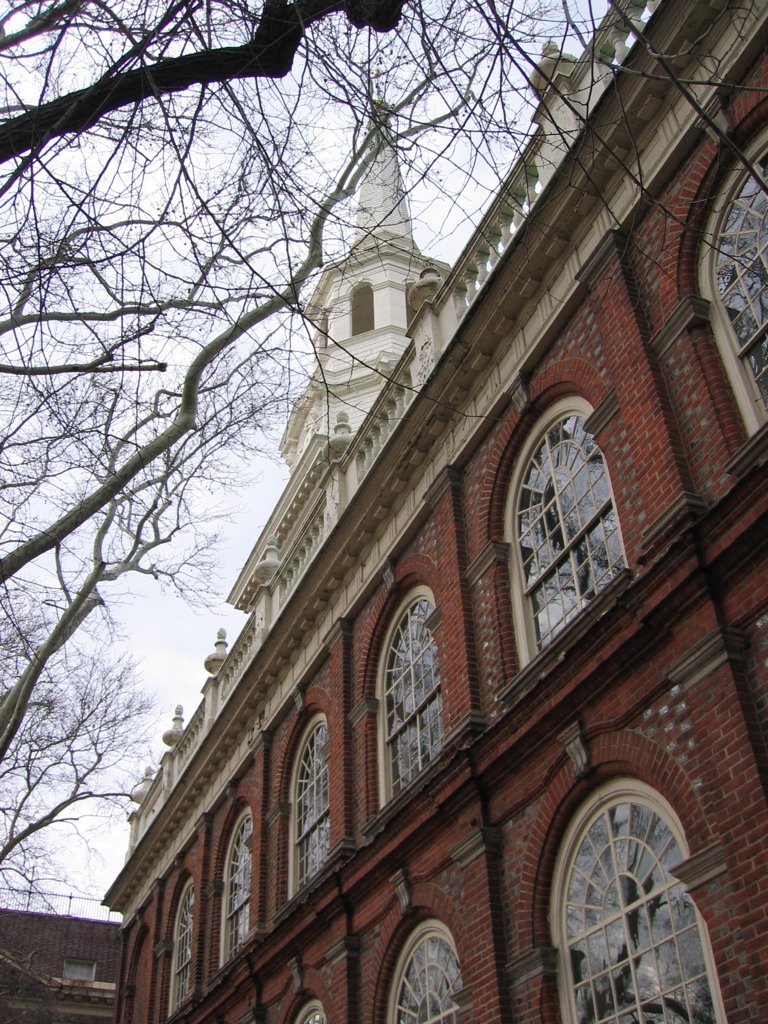- Christ Church, Philadelphia
Infobox_nrhp | name =Christ Church
Episcopal
nrhp_type = nhl

caption =
location= 22-26 North 2nd St.Philadelphia, Pennsylvania
lat_degrees = 39
lat_minutes = 57
lat_seconds = 2.60
lat_direction = N
long_degrees = 75
long_minutes = 8
long_seconds = 37.90
long_direction = W
locmapin = Pennsylvania
area =
built =1727-1744
architect= Unknown
architecture= Georgian
added =April 15 ,1970
governing_body =Christ Church Philadelphia
refnum=70000553cite web|url=http://www.nr.nps.gov/|title=National Register Information System|date=2007-01-23|work=National Register of Historic Places|publisher=National Park Service]Christ Church is an Episcopal church located in Philadelphia,
Pennsylvania . It was founded in 1695 by members of theChurch of England , who built a small wooden church on the site by the next year. When the congregation outgrew this structure some twenty years later, they decided to erect a new church, the most sumptuous in the colonies. Constructed between 1727 and 1744, Christ Church is considered one of the nation's most beautiful surviving 18th-century structures, a monument to colonial craftsmanship and a handsome example ofGeorgian architecture . It features a symmetrical, classical façade with arched windows and a simple yet elegant interior with fluted columns and wooden pews. The baptismal font in whichWilliam Penn was baptized is still in use at Christ Church; it was sent to Philadelphia in 1697 from All Hallows by the Tower inLondon .History
Christ Church's congregation included 15 signers of the
Declaration of Independence .Revolutionary War leaders who attended Christ Church includeGeorge Washington , Robert Morris,Benjamin Franklin andBetsy Ross (after she had been read out of the Quaker meeting house to which she belonged for marrying John Ross, son of an assistant rector at Christ Church). Brass plaques mark the pews where these individuals once sat. At the convening of theFirst Continental Congress in September, 1774, RectorJacob Duché was summoned toCarpenters' Hall to lead the opening prayers. During the war, the Reverend William White (1748-1836), rector of Christ Church, served as Chaplain to both theContinental Congress and to theUnited States Senate .As the first Protestant Episcopal church in the country, Christ Church is the birthplace of the American Episcopal Church in the United States. In September 1785, clerical and lay deputies from several states met in Christ Church and organized as a general convention, of which White was chosen president. He prepared a draft constitution for the church as well as an address to the archbishops and bishops of the Church of England, asking for the episcopate at their hands. White was also largely responsible for the liturgy and offices of the first American
Book of Common Prayer (published in 1789), which were to be submitted to Church of England authorities. At the convention of the Diocese of Pennsylvania in 1786, he was elected its first bishop and sailed for England with Dr.Samuel Provoost of New York, seeking consecration. After passage of a special enabling act by Parliament, White and Provoost were consecrated in early 1787 by the archbishops of Canterbury and York. Bishop White returned to Philadelphia that Easter Sunday. In 1789, under White's direction, the first meeting of theHouse of Bishops was held at Christ Church, marking the first trueGeneral Convention of the Episcopal Church in the United States of America . White was the first Episcopal Bishop of Pennsylvania and served the congregations of Christ Church and St. Peter's Church for decades. White is buried in the church's chancel.Christ Church is a
National Historic Landmark and a unique historic site that continues its original function as an Episcopal parish. More than 250,000 tourists visit the church each year.Notable interments
Several notable people are buried in the church and adjacent churchyard, including:
*Jacob Broom (1752–1810), signer of theUnited States Constitution fromDelaware [http://www.christchurchphila.org/Historic_Christ_Church/Burial_Ground/The_Graves/98/ The Graves, Christ Church, Philadelphia, official site] ]
*Pierce Butler (1744–1822), signer of theUnited States Constitution
*Elizabeth Graeme Ferguson (1739–1801), poet, early American writer
*General John Forbes (1710–1759), commander during the French and Indian War
*Andrew Hamilton (1676–1741), lawyer known as "The Philadelphia Lawyer"
*Charles Lee (1731–1782), Revolutionary War Continental Major General [ [http://www.findagrave.com/cgi-bin/fg.cgi?page=gr&GRid=613 Gen. Charles Lee] atFind A Grave ]
*Robert Morris (1734–1806), signer of theUnited States Declaration of Independence , theArticles of Confederation , and theUnited States Constitution
*John Penn (1729–1795), governor and proprietor of provincialPennsylvania
*James Wilson (1742–1798), signer of theUnited States Declaration of Independence and theUnited States Constitution
*Rev.William White (1748–1836), rector of Saint Peter Church and Christ Church, first Episcopal Bishop of PennsylvaniaMany other notable people are buried at nearby associated
Christ Church Burial Ground , includingBenjamin Franklin and four other signers of the Declaration of Independence.References
External links
* [http://oldchristchurch.org Christ Church tourism web site]
* [http://christchurchphila.org Christ Church parish web site]
* [http://www.findagrave.com/cgi-bin/fg.cgi?page=cr&GRid=613&CRid=641287& Christ Episcopal Churchyard] atFind-A-Grave ###@@@KEY@@@###succession box| before=Unknown
title=Tallest Building in Philadelphia| years=1754—1901 60m| after=Philadelphia City Hall succession box| before=Unknown
title=Tallest Building in Pennsylvania| years=1754—1901 60m| after=Philadelphia City Hall
Wikimedia Foundation. 2010.
